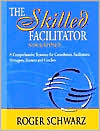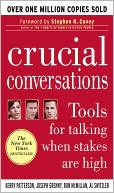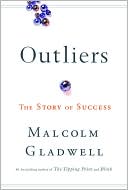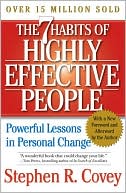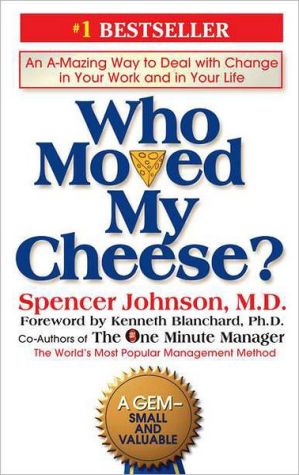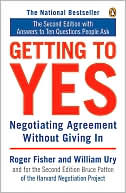The Skilled Facilitator: A Comprehensive Resource for Consultants, Facilitators, Managers, Trainers, and Coaches
"Everyone wants to be a facilitator: consultants, managers, even teachers. What is desperately needed is a common, practical reference for understanding facilitation in diverse professional settings. No one has done a better job than Roger Schwarz of synthesizing the major theoretical underpinnings and translating them into clear, usable guidelines for practitioners."\ — Peter M. Senge, author, The Fifth Discipline\ "The Skilled Facilitator has always been an outstanding resource for new and...
Search in google:
When it was published in 1994, Roger Schwarz's The Skilled Facilitator earned widespread critical acclaim and became a landmark in the field. The book is a classic work for consultants, facilitators, managers, leaders, trainers, and coaches—anyone whose role is to guide groups toward realizing their creative and problem-solving potential. This thoroughly revised edition provides the essential materials for facilitators and includes simple but effective ground rules for group interaction. Filled with illustrative examples, the book contains proven techniques for starting meetings on the right foot and ending them positively and decisively. This important resource also offers practical methods for handling emotions when they arise in a group and offers a diagnostic approach for identifying and solving problems that can undermine the group process. Based on Schwarz's practical experience working in the field and the feedback he has received in his dynamic workshops, this revised edition is easier to use and much more accessible. Grounded in the latest thinking on teams, organization development, and facilitation, this new edition Takes a more conversational approach Offers a clear analysis of the Skilled Facilitator approach, based on a set of core values, assumptions, and principles Defines the five facilitative roles—facilitator, leader, coach, consultant, and trainer Shows how groups can act inconsistently with ground rules and what to do to intervene Describes the theories that guide a facilitator's actions The Skilled Facilitator also includes practical advice on how to work with outside consultants and how to facilitate groups within one's own organization, along with a groundbreaking section on facilitative leadership. Booknews Written for consultants, facilitators, managers, leaders, trainers, and coaches, this book presents techniques for running meetings, theories of facilitation, ground rules for group interaction, diagnostic approaches to problem solving, skills for intervention, and examples of how each can be applied in different settings. Appendices include sample ground rules, planning letters, guidelines for contract negotiation, agreements for facilitation, experimental exercises, questions of co-facilitators, and the like. Schwarz is an organizational psychologist and consultant. Annotation c. Book News, Inc., Portland, OR (booknews.com)
The Skilled Facilitator\ A Comprehensive Resource for Consultants, Facilitators, Managers, Trainers, and Coaches \ \ By Roger Schwarz \ John Wiley & Sons\ ISBN: 0-7879-4723-7 \ \ \ Chapter One\ The Skilled Facilitator Approach \ In this opening chapter, I briefly illustrate the need for facilitation, define group facilitation, and give an overview of the Skilled Facilitator approach. We also see the key elements and how they fit together to form a values-based systemic approach to facilitation.\ THE NEED FOR GROUP FACILITATION\ Groups are becoming the basic work unit of organizations. Increasingly, we turn to groups to bring together differing views, produce quality products and services, and coordinate complex work. In doing so, we expect groups to work effectively so that the product of their efforts is greater than the sum of the parts. Yet our experience with groups often leaves us feeling disappointed or frustrated. Consider these examples:\ A division manager, Michael, and his department heads meet regularly to solve divisionwide problems. Michael has specific recommendations in mind but is concerned that if he shares his views early on, the department heads won't share their true opinions or buy in to his recommendations. So Michael asks the department heads a series of questions about the problems, while withholding his own opinions. The department heads begin to feel that they are being quizzed and that Michael is looking for certainanswers. Uncertain what the answers are, the department heads grow careful, giving their views in vague terms so they do not commit to a position that might be at odds with their boss. Frustrated with what he considers inadequate response, Michael reacts by telling the group how the problems are to be solved. The department heads reluctantly agree, but they are not committed to the decisions, which end up being poorly implemented. After the meetings, the department heads discuss privately how Michael is not sharing decision-making authority as he had agreed. Down the hall, Michael confides to his assistant that he will be reluctant to give his department heads more say in decisions if they do not demonstrate clearer reasoning in these situations. No one ever discusses in the full group the concerns aired after each meeting.\ A board meets every other week to make policy decisions. Each time an issue comes up, members take sides and push their positions. They rarely share their reasons for taking a position, and no one asks. Each member believes that others are taking a position from questionable motives. Members leave the meetings frustrated and angry, sometimes even after winning a vote. Despite all the decisions they make, members feel the board has no unified direction.\ Members of an aspiring self-directed team believe that a couple of members, Cora and Dean, are not doing quality work. The members talk about this among themselves but never raise the issue directly with Cora and Dean because they are concerned that Cora and Dean will get embarrassed and defensive. Instead, the other team members choose to redo the work for the two. As the situation gets worse, the team members ask their leader, Leticia, to talk to Dean and Cora. She agrees and then finds herself in a conversation with them without any firsthand information about the situation, and with no other team members to respond to the pair's questions and concerns. Cora and Dean resent being talked to by Leticia without having the team members present. Little is resolved, the relationship between the two members and the rest of the team worsens, and the team's performance drops.\ A newly formed group comprising representatives from local business organizations, the police department, community groups, and the schools meet to try to figure out how to reduce crime in their community. All the members agree on the group's goals and are willing to devote time, energy, and money to solve the problem. Yet the group members' optimism quickly evaporates as they begin to blame each other for causing the problem.\ A top management team meets to solve a complicated problem that affects the entire organization. All are experienced, successful executives, and they quickly identify a solution and implement it. Just as they think they have solved the problem, it returns in another form, and the problem gets worse.\ Groups do not have to function in ways that lead to ineffective performance, make it difficult for members to work together, and frustrate members. Groups can improve how they work.\ This book is about helping work groups improve their effectiveness by using facilitative skills. It is about helping all types of work groups: top management teams, boards, committees, work teams, cross-functional teams, interorganizational groups, quality groups, task forces, and employee-management or union-management groups. Anyone who works with others needs facilitative skills.\ Organizational consultants, internal and external, need facilitative skills when they contract with clients, diagnose problems, and recommend solutions. Leaders and managers need facilitative skills to explore stakeholders' interests and to craft solutions based on sound data that generate commitment.\ Because organizations change constantly, the need for facilitative skills to support change is always increasing. This applies to a merger or acquisition, or downsizing, and to efforts to improve the quality of products and services, empower employees, develop a shared vision, develop a self-managing work team, create a learning organization, or develop an organizational culture that makes these changes possible.\ Organizations typically use groups to plan and implement change, and groups typically need some form of facilitation. In addition, facilitative skills have become more important as organizations try to openly and constructively manage conflict arising from the change they try to create.\ At the heart of improving group effectiveness lies the ability of group members to reflect on what they are doing, to create the conditions necessary to achieve their goals. Groups find it difficult to openly examine behavior on their own; they often need the help of a facilitator.\ WHAT IS GROUP FACILITATION?\ Group facilitation is a process in which a person whose selection is acceptable to all the members of the group, who is substantively neutral, and who has no substantive decision-making authority diagnoses and intervenes to help a group improve how it identifies and solves problems and makes decisions, to increase the group's effectiveness.\ The facilitator's main task is to help the group increase effectiveness by improving its process and structure. Process refers to how a group works together. It includes how members talk to each other, how they identify and solve problems, how they make decisions, and how they handle conflict. Structure refers to stable recurring group process, examples being group membership or group roles. In contrast, content refers to what a group is working on. The content of a group discussion might be whether to enter a new market, how to provide high-quality service to customers, or what each group member's responsibilities should be. Whenever a group meets, it is possible to observe both content and process. For example, in a discussion of how to provide high-quality service, suggestions about installing a customer hotline or giving more authority to those with customer contact reflect content. However, members responding to only certain colleagues' ideas or failing to identify their assumptions are facets of the group's process.\ Underlying the facilitator's main task is the fundamental assumption that ineffective group process and structure reduces a group's ability to solve problems and make decisions. Although research findings on the relationship between process and group effectiveness are mixed (Kaplan, 1979), the premise of this book is that by increasing the effectiveness of the group's process and structure the facilitator helps the group improve its performance and overall effectiveness. The facilitator does not intervene directly in the content of the group's discussions; to do so would require the facilitator to abandon neutrality and reduce the group's responsibility for solving its problems.\ To ensure that the facilitator is trusted by all group members and that the group's autonomy is maintained, the facilitator should be acceptable to all members of the group; this person needs to be substantively neutral-that is, display no preference for any of the solutions the group considers-and not have substantive decision-making authority. In practice, the facilitator can meet these three criteria only if he or she is not a group member. A group member may be acceptable to other members and may not have substantive decisionmaking authority yet have a substantive interest in the group's issues. By definition, a group member cannot formally fill the role of facilitator. Still, a group leader or member can use the principles and techniques I describe in this book to help a group. Effective leaders regularly facilitate their groups as part of their leadership role.\ To intervene means "to enter into an ongoing system" for the purpose of helping those in the system (Argyris, 1970, p. 15). The definition implies that the system, or group, functions autonomously-that is, the group is complete without a facilitator. Yet the group depends on a facilitator for help. Consequently, to maintain the group's autonomy and to develop its long-term effectiveness, the facilitator's interventions should decrease the group's dependence on the facilitator. Ideally, the facilitator accomplishes this by intervening in a way that teaches group members the skills of facilitation.\ THE SKILLED FACILITATOR APPROACH\ The Skilled Facilitator approach is one approach to facilitation. It is an approach I have been developing since 1980, when I began teaching facilitation skills to others. Facilitation approaches often represent a compilation of techniques and methods without an underlying theoretical framework. The Skilled Facilitator approach is based on a theory of group facilitation that contains a set of core values and principles and a number of techniques and methods derived from the core values and principles. It integrates theory into practice to create a values-based, systemic approach to group facilitation. Exhibit 1.1 identifies the key elements of the Skilled Facilitator approach and their purpose.\ The Group Effectiveness Model\ To help groups become more effective, you need a model of group effectiveness as part of your approach. To be useful, the model needs to be more than descriptive; it has to do more than explain how groups typically function or develop, because many groups develop in a way that is dysfunctional. To be useful, the model needs to be normative; that is, it should tell you what an effective group looks like. The group effectiveness model identifies the criteria for effective groups, identifies the elements that contribute to effectiveness and the relationships among them, and describes what these elements look like in practice. The model enables you to identify when groups are having problems, identify the causes that generate the problems, and begin to identify where to intervene to address them. If you are creating new groups, the model helps identify the elements and relationships among them that must be in place to ensure an effective group.\ A Clearly Defined Facilitative Role\ To help groups, you need a clear definition of your facilitator role so that you and the groups you are helping have a common understanding about the kinds of behavior that are consistent and inconsistent with your facilitator role. This has become more difficult in recent years, as organizations now use the word facilitator to indicate many roles. Human resource experts, organization development consultants, trainers, coaches, and even managers have sometimes been renamed "facilitators." The Skilled Facilitator approach clearly defines the facilitator role as a substantively neutral person who is not a group member and who works for the entire group.\ The Skilled Facilitator approach distinguishes between two types of facilitation: basic and developmental. In the basic type, the facilitator helps a group solve a substantive problem by essentially lending the group his or her process skills. Once the facilitation is complete, the group has solved its substantive problem, but by design it has not learned how to improve its process. In the developmental type, the facilitator helps a group solve a substantive problem and learn to improve its process at the same time. Here the facilitator also serves as a teacher so the group can eventually become self-facilitating. Developmental facilitation requires significantly more time and facilitator skill, and it is more likely to create fundamental change.\ Useful in a Range of Roles\ Although I have described the Skilled Facilitator approach as having a substantively neutral third-party facilitator, the approach also recognizes that everyone needs to use facilitative skills even if not a neutral third party or not working in a group or team. So the Skilled Facilitator approach introduces roles in addition to facilitator:\ Facilitative consultant\ Facilitative coach\ Facilitative trainer\ Facilitative leader\ All of these roles are based on the same underlying core values and principles as the role of facilitator. In addition, many of my clients have told me that they use the core values and principles outside the workplace, with their families and friends, and see positive results. The approach is broadly applicable because it is based on principles of effective human interaction. Consequently, if you use this approach across your roles in life, you are likely to be viewed by others as acting consistently and with integrity regardless of the situation.\ Explicit Core Values\ All approaches to facilitation are based on some core values. They are the foundation for an approach and serve as a guide. They enable you to craft new methods and techniques consistent with the core values and to continually reflect on how well you do in acting congruently with the values. But if you are to benefit most from the core values, they need to be explicit. The Skilled Facilitator approach is based on an explicit set of four core values, and on principles that follow from them (see Exhibit 1.2). The first three core values come from the work of Chris Argyris and Donald Schön.\ Making core values explicit has several benefits.\ \ Continues...\ \ \ \ Excerpted from The Skilled Facilitator by Roger Schwarz Excerpted by permission.\ All rights reserved. No part of this excerpt may be reproduced or reprinted without permission in writing from the publisher.\ Excerpts are provided by Dial-A-Book Inc. solely for the personal use of visitors to this web site. \ \
Preface to the Revised EditionAcknowledgmentsThe Author1The Skilled Facilitator Approach32What Makes Work Groups Effective?173The Facilitator and Other Facilitative Roles404Understanding the Theories That Guide Our Actions655Ground Rules for Effective Groups966Diagnosing Behaviors that Enhance or Hinder Group Effectiveness1367Deciding Whether, How, and Why to Intervene1618How to Intervene1759Using the Ground Rules to Intervene19510Using the Skilled Facilitator Approach with Other Processes21511Beginning and Ending Meetings23312Dealing with Emotions24613Contracting: Deciding Whether and How to Work Together27114Working with Another Facilitator29615Serving as Facilitator in Your Own Organization31516The Facilitative Leader327Resource ACurrent and Previous Ground Rules345Resource BSample Planning Meeting Letter349Resource CGuidelines for Developing an Effective Contract353Resource DSample Agreement for Basic Facilitation365Resource ESample Agreement for Developmental Facilitation369Resource FGuidelines for Using Experiential Exercises and Self-Knowledge Instruments373Resource GQuestions for Cofacilitators377Resource HGuidelines for Contracting with Your Manager381References385Index391
\ BooknewsWritten for consultants, facilitators, managers, leaders, trainers, and coaches, this book presents techniques for running meetings, theories of facilitation, ground rules for group interaction, diagnostic approaches to problem solving, skills for intervention, and examples of how each can be applied in different settings. Appendices include sample ground rules, planning letters, guidelines for contract negotiation, agreements for facilitation, experimental exercises, questions of co-facilitators, and the like. Schwarz is an organizational psychologist and consultant. Annotation c. Book News, Inc., Portland, OR (booknews.com)\ \
